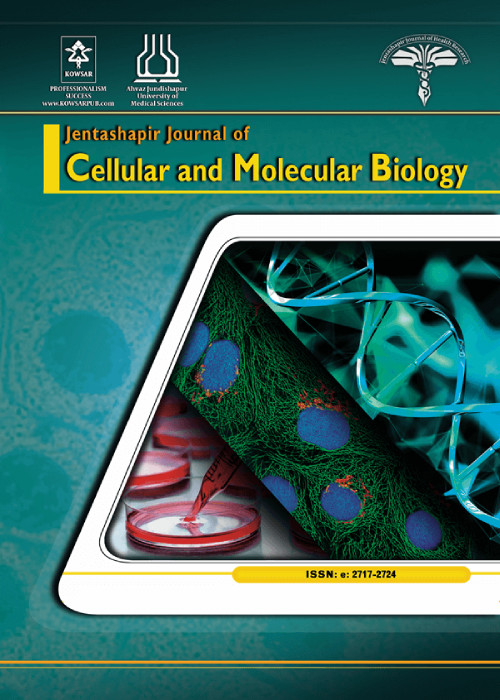فهرست مطالب
Jentashapir Journal of Cellular and Molecular Biology
Volume:11 Issue: 1, Mar 2020
- تاریخ انتشار: 1399/07/15
- تعداد عناوین: 2
-
-
Page 1Background
Cervical cancer (CC) is one of the most common malignant tumors in women, which has been diagnosed as fourth cancer in females worldwide. In addition to human papillomavirus (HPV), genetic factors, including altered expression of some microRNAs and mutations in tumor necrosis factor α (TNF-α) gene, are involved in this cancer.
ObjectivesThis study aimed to investigate the rs11614913 polymorphism from the miRNA196a gene and its association with the expression of the TNF-α gene in cervical cancer for early diagnosis and treatment.
MethodsIn this study, 52 samples of pre-cancerous and cancerous lesions, and 50 tissue samples were collected from healthy subjects in an Iranian population. DNA was extracted from the samples, and rs11614913 polymorphism of the miRNA196a gene was investigated by PCR. RNA was extracted from the samples, and the expression of the miRNA196a and TNF-α genes were evaluated. Finally, for data analysis, Epi Info software version 7.1.3.10 and MedCalc Version 19.2.0 were used.
ResultsThe frequency of CC, TC, and TT genotypes from rs11614913 polymorphism of miRNA196a gene was 0.58, 0.34, and 0.08, respectively, but in the healthy group it was 0.36, 0.46, and 0.18, respectively. The results also showed that the expression of miRNA196a and TNF-α genes in the patient group was higher than the control group.
ConclusionsBased on the results of this study, a significant correlation was found between CC genotype and rs11614913 polymorphism of miRNA196a gene and TNF-α gene expression in the cervical cancer sample. Therefore, investigating these factors in patients with cervical cancer may be helpful.
Keywords: Cervical Cancer, TNF-α, Human Papillomavirus, miRNA196a, rs11614913 -
Page 2Background
The need for on-demand biological products has been raised during the last decades. To prepare ready-to-use organ-related products, it necessitates a bulk cell reservoir. In this regard, stem cells, especially mesenchymal stem cells, have numerous therapeutic properties in tissue repair. Therefore, the advent of novel cell banking systems is inevitable to maintain cells ready-to-use.
ObjectivesIn the current study, the cryoprotective effects of alginate-gelatin were investigated on human mesenchymal stem cells after seven days.
MethodsMesenchymal stem cells were classified into two groups; the Control and Encapsulated cells. Cells were encapsulated by using the mixture of alginate (1% v/v) and 2% gelatin and 1% CaCl2, a cross-linker, and vitrified in liquid nitrogen in freezing medium containing 10% dimethyl sulfoxide. After seven days, mesenchymal stem cells were thawed and decapsulated by 0.01 M sodium citrate solution. The cell survival rate was monitored by using MTT assay. Flow cytometry analysis of annexin-V/PI was used to determine the number of apoptotic cells.
ResultsThese data showed that encapsulation had a superior effect on maintaining cell viability after the freeze-thaw procedure compared to the control group (P < 0.05). We found a significant decrease in the number of early- and late-stage apoptotic cells in mesenchymal stem cells inside the alginate-gelatin microspheres seven days after deep freezing (P < 0.05). As expected, cell cycle analysis specified the lack of dynamic activity in cells from both groups. Cells at phases S and G2/M reached zero.
ConclusionsThese findings showed that encapsulation of human mesenchymal stem cells with alginate-gelatin microspheres could reduce deep freeze/thaw insult and decrease the detrimental effect of cryoprotectant compared to non-capsulated cells.
Keywords: Apoptosis, Cell Survival, Human Mesenchymal Stem Cells, Alginate-Gelatin Microsphere, Deep Freeze-Thaw


